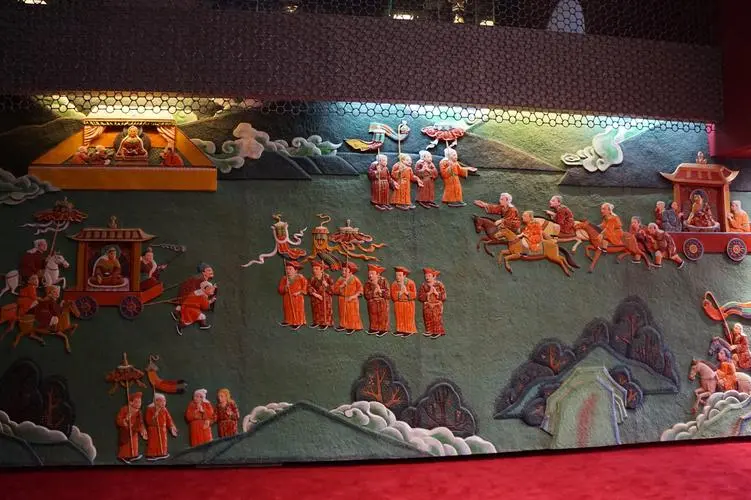Overview
Chinese Name: 布达拉宫
English Name: Potala Palace; BuDaLaGong;Lhasa-Budalagong
Location: Tibet
Type: Ancient culture and art
Rating Level: AAAAA (5A)
Website: http://www.potalapalace.cn/home.html

Brief Introduction
Located on Mount Maburi 玛布日山 in the northwest of Lhasa, the capital of Tibet, China, the Potala Palace is a palace-like complex originally built by the Tubo Dynasty’s King Songtsen Gampo 松赞干布 to marry Princess Wencheng 文成公主.
After being rebuilt in the 17th century, it became the winter residence of successive Dalai Lamas 达赖喇嘛 and was the center of the theocratic rule in Tibet. In 1961, the Potala Palace became one of the first batches of national key cultural relics protection units of the State Council of the People’s Republic of China.

In 1994, the Potala Palace was listed as a World Heritage Site. The main building of the Potala Palace is the White House and the Red Palace.
The whole palace has a Tibetan style, more than 200 meters high, with the appearance of 13 floors, the actual only 9 floors. Because it was built on the mountainside, the large stone wall stood like a cliff, making the building seem to merge with the hill and be majestic.

History of Potala Palace
The basic appearance of the palace is mainly the White House rebuilt during the reign of the Fifth Dalai Lama in the 17th century AD and the Red Palace built after its death, and since then the Successive Dalai Lamas have expanded successively, and finally become the scale of the Potala Palace today.
Lhasa-Budalagong was built in the 7th century during the reign of King Sotsen Gampo and has a history of 1300 years.

In the 1930s, the 33rd generation of Tubo 吐蕃, Songtsen Gampo moved the capital to Lhasa 拉萨, and Lhasa-Budalagong was built as a royal palace. According to historical records, there is a silver and copper bridge between the outer city of Mount Hong 红山, Songtsen Gampo, and Princess Wencheng Palace. Outside the east gate of the Palace, there is the racecourse of Songtsen Gampo. When the Tubo Dynasty founded by Songtsen Gampo was destroyed, much of the Palace was destroyed by war.

After the fall of the Tubo Dynasty, most of the ancient palace forts were destroyed by war, coupled with natural disasters such as lightning strikes, Lhasa-Budalagongwas gradually reduced in size, and even once included in the Jokhang Temple, as its branch for management. Today’s Potala Palace only has the then Fa Wang Cave 法王洞 and Pabalakang 帕巴拉康.
What are worth visiting and seeing?
Architectures
The White Palace 白宫, the Dalai Lama’s winter residence, was once the seat of the former local government of Tibet, seven stories high.
The White House is named after the white façade, and the oldest surviving building of Lhasa-Budalagong is the Fa Wang Cave. In the 9th century, the Potala Palace was destroyed due to civil strife in Tibet, and only the Fa Wang Cave remained. Inside the cave are statues of himself, which are said to have been made by Songtsen Gampo, alongside Princess Wencheng and Bhrikuti Devi 尺尊公主 of Nepal.

The Red Palace 红宫 is located in the center of the Palace, with a red façade. The palace adopts a mandala layout, and many prayer halls and Buddhist halls are built around the ancestral hall 灵塔殿 of the Dalai Lama in previous dynasties, thus connecting with the White House.
The Red Palace is mainly the ancestral hall of the Dalai Lama and various Buddhist halls, with a total of 8 ancestral halls storing the Dharma bodies of the Dalai Lamas, of which the Fifth Dalai Lama’s Spiritual Pagoda is the largest. The West Yousheng Hall is the ancestral hall of the Fifth Dalai Lama and the largest hall of the Potala Palace, with an area of 725 square meters and the inner wall is full of frescoes.

Mural
The interior of Lhasa-Budalagong is painted with a large number of murals, forming a huge gallery of painting art, and nearly 200 people have participated in the mural painting, which has been used for more than ten years.
The themes of the murals include the history of the development of Buddhism in Tibet, the life of the Fifth Dalai Lama, the process of Princess Wencheng’s entry into Tibet, the ancient architectural images of Tibet and a large number of Buddha statues, and Vajrapani 金刚手菩萨 is a precious historical painting. The halls of the Potala Palace contain a large number of precious cultural relics and Buddhist artworks.

Murals are diverse and rich in content, fine techniques, bright colors, take the theme of murals, there are historical figures and historical stories, there are also religious myths and Buddhist scripture stories, as well as the performance of architecture, folklore, sports, entertainment, and another rich atmosphere of life.

See Potala Palace, the Iconic Heart of Tibetan Buddhism | National Geographic
You might be interested in: